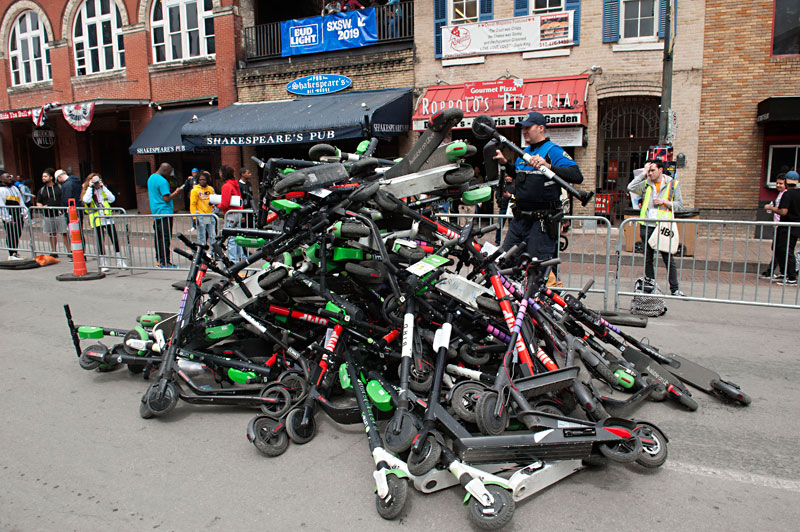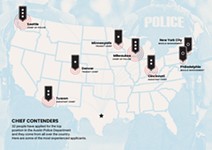City Council to Continue Considering Scooters in August
With basic rules in place, regulatory framework remains undecided
By Austin Sanders, Fri., May 31, 2019
Having approved at last week's meeting, May 23, rules of the road (and sidewalk) for scooters and other "micro-mobility" devices, City Council still has to grapple with the rules of the marketplace where they operate; consideration of those draft ordinances has been deferred until August. For now, scooter and dockless bike and e-bike riders can use sidewalks throughout the city, as long as they ride in a "reasonable and prudent manner" – a deliberately vague phrase intended to help law enforcement determine culpability after an incident, instead of defining behavior they would proactively police. Riders can also use electronic devices in hands-free mode; parents are responsible for ensuring children under 18 wear helmets; and more than one rider per scooter is not allowed. Violators face warnings, then fines should they continue to misbehave. As for riding on trails and parkland, the city's current pilot program allowing scooters on certain trails will wrap up by summer's end, with additional rules to be crafted thereafter.
The harder part has been establishing a regulatory framework for how micro-mobility providers interact with the city – right now, that mostly means Bird, Lime, JUMP (an Uber brand), and Lyft. Initially, staff recommended a franchise model such as the city uses for taxis, but the providers say that would be too cumbersome; operators would need Council approval at multiple meetings before they could enter the market or make major changes to their current fleets.
Council Members Jimmy Flannigan, Paige Ellis, and Natasha Harper-Madison were receptive to this reasoning and jointly moved to postpone approvals until after Council's summer break. Their motion also directed staff to work with stakeholders to "explore, develop, and present all potential models" for regulating micro-mobility companies – including a "revised franchise model." These models should include "basic design specifications" to make riding with different companies safer and more consistent; encouragement of competition in the market to spread the devices, "especially in areas outside downtown"; rules for data sharing with governmental entities without infringing upon civil liberties; and, crucially, a way to bring in revenue to support the "expansion of infrastructure that supports safe operation of micro-mobility devices and bicycles."
In a conversation with the Chronicle this week, Flannigan emphasized that he was not necessarily opposed to a franchise model, but he was unsatisfied with simply repurposing the existing taxi system. With state-imposed revenue caps now looming, he explained, it's important for the city to think through its partnerships with private companies: "I'm hoping to see a model that allows the city to collect a fair fee for [enabling] commerce in the public right of way, and I'm hopeful that we will see a minimum set of standards for the physical devices themselves."
Staff sees the franchise model as a proven way to collect fees that could then be spent on the city's mobility infrastructure. Jason JonMichael, assistant director of the Austin Transportation Department, said it would be critical for the city to cover not only capital improvements but administrative costs; it's too early to say what other options could work, but ATD and the city's lawyers have the summer to find out.
The time City Hall has already invested in micro-mobility reflects how scooters are likely not a fad, but a feature of our future. This May alone, more than 480,000 individual micro-mobility trips have been taken in Austin (93% of those on scooters), with nearly 17,000 devices on the street and an average trip length of just over a mile. (ATD notes that this exceeds the number of automobile trips of similar length.) While anecdotes cast scooters as a scourge on our streets, the data suggests they are helping the city achieve the goal, adopted with the Austin Strategic Mobility Plan in April, of a 50-50 mode split between single-driver car trips and less carbon-laden and injury-prone modes of transportation.
Advocates insist micros can only be useful to the extent that policymakers prioritize their usage over cars. That means improving comfort and safety by building out mobility infrastructure for modes other than cars, but it also means disincentivizing driving and encouraging transit use, with scooters and bikes as a "first/last mile" solution. As UT professor and transportation researcher Alex Karner told the Chronicle, "Ideally we want to create a city where we don't have to get into a car. ... If we want to do that, walking, scooting, or using a wheelchair has to become safe and normal."
With some on Council still largely viewing scooters as a hazard that pedestrians need protection from, it's unclear how hard the city will push for this outcome, although scooters clearly need to be factored into our consideration of walkable communities and transit corridors.
Got something to say on the subject? Send a letter to the editor.











